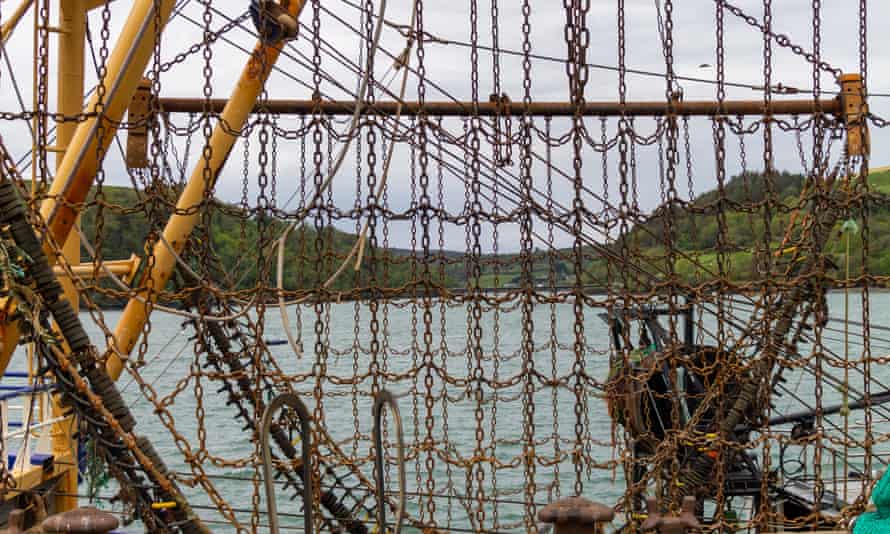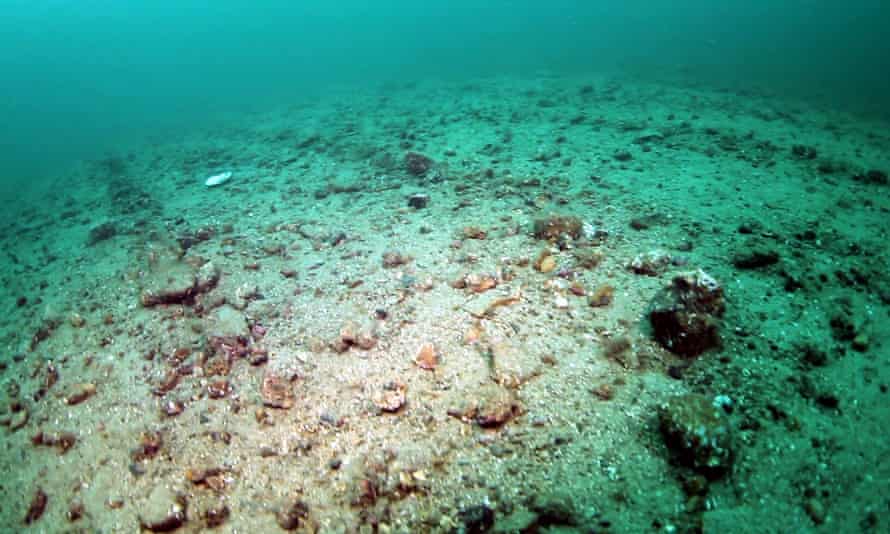An area of seabed damaged by trawling. Bottom trawling by fishing boats pumps out 1 gigaton of carbon every year.
Photograph: Marine Conservation Society/PA
From The Guardian by Karen McVeigh
Dragging heavy nets across seabed disturbs marine sediments, world’s largest carbon sink, scientists report
Fishing boats that trawl the ocean floor release as much carbon dioxide as the entire aviation industry, according to a groundbreaking study.
Bottom trawling, a widespread practice in which heavy nets are dragged along the seabed, pumps out 1 gigaton of carbon every year, says the study written by 26 marine biologists, climate experts and economists and published in Nature on Wednesday.
The carbon is released from the seabed sediment into the water, and can increase ocean acidification, as well as adversely affecting productivity and biodiversity, the study said. Marine sediments are the largest pool of carbon storage in the world.
The report – Protecting the global ocean for biodiversity, food and climate – is the first study to show the climate impacts of trawling globally.
It also provides a blueprint outlining which areas of the ocean should be protected to safeguard marine life, boost seafood production and reduce climate emissions.
Only 7% of the ocean is under some kind of protection.
The scientists argue that, by identifying strategic areas for stewardship – for example, regions with large-scale industrial fishing and major economic exclusion zones or marine territories – nations could reap “significant benefits” for climate, food and biodiversity.
Protecting “strategic” ocean areas could produce 8m tonnes of seafood, they say.
Humanity and the economy benefit from a healthier oceanDr Enric Sala, scientist
“Ocean life has been declining worldwide because of overfishing, habitat destruction and climate change,” said Dr Enric Sala, explorer-in-residence at the National Geographic Society and lead author of the paper.
“In this study, we’ve pioneered a new way to identify the places that – if strongly protected – will boost food production and safeguard marine life, all while reducing carbon emissions.
“It’s clear that humanity and the economy will benefit from a healthier ocean. And we can realise those benefits quickly if countries work together to protect at least 30% of the ocean by 2030.”
The scientists identified marine areas where species and ecosystems face the greatest threats from human activities.
They developed an algorithm to identify regions where safeguarding would deliver the greatest benefits across three goals: biodiversity protection, seafood production and climate mitigation. They then mapped these to create a practical “blueprint” that governments can use, depending on their priorities.
The top 10 countries with the most carbon emissions from bottom trawling, and therefore the most to gain, were China, Russia, Italy, UK, Denmark, France, the Netherlands, Norway, Croatia and Spain.
 Beam trawlers’ heavy chains are dragged along the seabed, releasing carbon into the seawater.
Beam trawlers’ heavy chains are dragged along the seabed, releasing carbon into the seawater. Photograph: aphperspective/Alamy
The analysis shows that the world must protect a minimum of 30% of the ocean in order to provide multiple benefits.
The scientists say their results lend credence to the
ambition of protecting at least 30% of the ocean by 2030, which is part of the target adopted by a coalition of 50 countries this year to slow the destruction of the natural world.
Zac Goldsmith, the UK minister for Pacific and the environment, described the paper as “an important contribution to the science on ocean protection and highlights the need for countries to work together to protect at least 30% of the global ocean by 2030”.
He said the UK was playing a leading role in a global ocean alliance supporting this target and promised: “We will do all we can to deliver it at the
UN biodiversity conference in China.”
“There is no single best solution to save marine life and obtain these other benefits. The solution depends on what society – or a given country – cares about, and our study provides a new way to integrate these preferences and find effective conservation strategies,” said Dr Juan S Mayorga, a report co-author and a marine data scientist with the Environmental Market Solutions Lab at the University of California, Santa Barbara and Pristine Seas at the National Geographic Society.
One notable priority for conservation is Antarctica, which has little protectionDr David Mouillot, co-author
The study calculates that eliminating 90% of the present risk of carbon disturbance due to bottom trawling would require protecting only about 4% of the ocean, mostly within national waters.
Dr David Mouillot, a report co-author and a professor at the Université de Montpellier in France, said: “One notable priority for conservation is Antarctica, which currently has little protection, but is projected to host many vulnerable species in the near future due to climate change.”
The study estimated the emissions at between 0.6 and 1.5 gigatons of carbon dioxide a year, or an average of 1 gigaton annually. Aviation emissions of carbon dioxide in 2019 were 918m tons.
The
UN’s biodiversity conference, Cop15, which is to be held in Kunming, China, this year, is expected to produce a global agreement for nature, building on the targets already set by some nations to protect at least 30% of the ocean by 2030.
Links :

 Beam trawlers’ heavy chains are dragged along the seabed, releasing carbon into the seawater.
Beam trawlers’ heavy chains are dragged along the seabed, releasing carbon into the seawater.
The Guardian : Trawl fishing ban off Sussex coast aims to restore seaweed forests
ReplyDelete